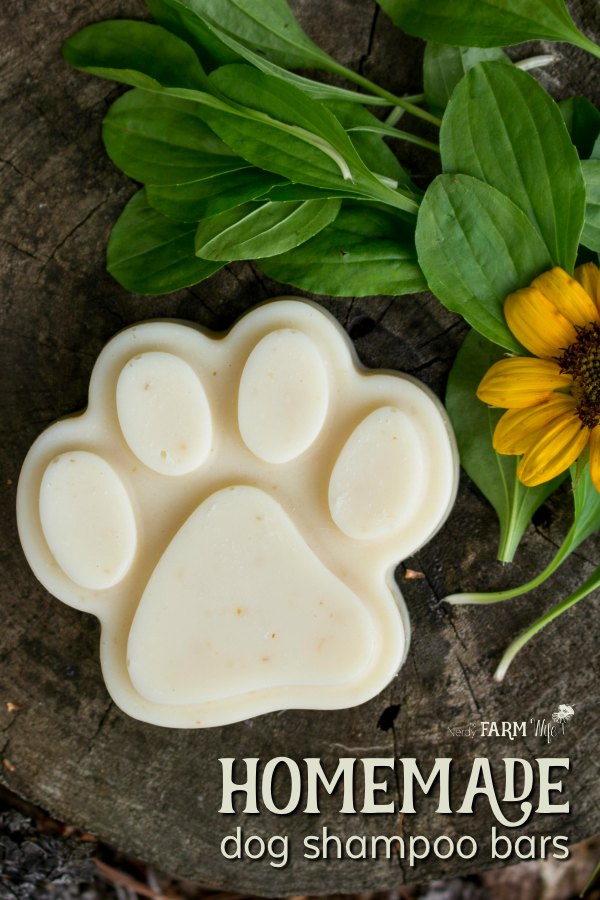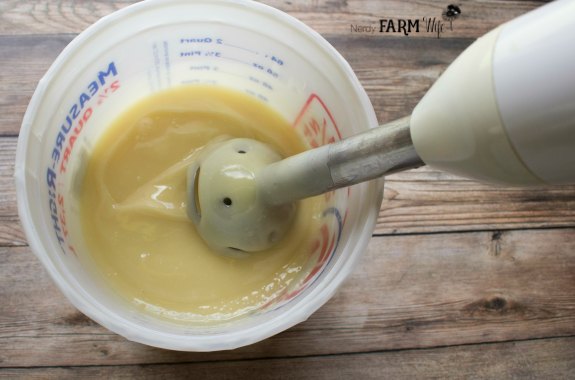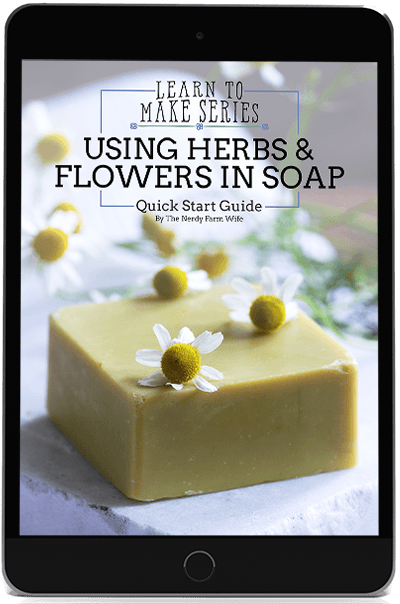Homemade Dog Shampoo Bars Recipe {with neem oil}
These natural homemade dog shampoo bars feature neem oil, which is especially helpful at repelling fleas and treating a variety of skin complaints.
Since neem has a fairly strong aroma, I also included some lavender essential oil to help mellow the scent and to add a calming note to bath times.

After washing your dog with a shampoo bar, follow with a diluted apple cider vinegar rinse (1 part vinegar to 1 to 2 parts water) to help remove any soap residue and to leave your dog’s coat clean and shiny. Rinse well.
Lavender infused vinegar is perfect for rinsing dogs with! You can find directions for making it in my Five Uses for Lavender Vinegar blog post.
Ingredients for Homemade Dog Shampoo Bars
This is a smaller batch of soap, containing just 20 ounces of oil, in order to make it perfectly fit this K9Cakery Silicone 6 Paw Pan from Amazon.
You’ll get six paw shaped soaps from this recipe.
All measurements are by weight. You must use an accurate scale to make soap.
- 7 oz (198 g) distilled water
- 2.75 oz (78 g) sodium hydroxide (lye)
- 9 oz (255 g) olive oil
- 4.5 oz (128 g) coconut oil
- 3 oz (85 g) castor oil
- 3 oz (85 g) tallow (or cocoa butter or kokum butter)
- 0.5 oz (14 g) neem oil
- 7 g lavender essential oil (abt 2 tsp)
Optional add-ins: 10 drops ROE (rosemary oleoresin extract or rosemary antioxidants) to extend shelf life + 3/4 tsp sodium lactate to harden soap faster. You can also add 1/2 tbsp finely ground oats or colloidal oatmeal.
Try infusing the olive oil and/or coconut oil with plantain leaves, calendula flowers, or violet leaves first, before making the soap.
Brands of lye that I recommend include: ComStar & Essential Depot Food Grade Lye – all can be found on Amazon.
Neem oil should not be handled by pregnant women, or those trying to conceive, nor should it be used on pregnant dogs.

Directions to Make Homemade Dog Shampoo Bars
If you’ve never made soap before, be sure to read over my Soap Making 101 tutorial before proceeding.
You may also find my Handmade Natural Soap eBook Collection helpful; it’s filled with guides, handy printables, tons of natural soap recipes!
- Put on goggles and gloves.
- Weigh the water into a stainless steel or heavy duty plastic container.
- Weigh the lye into a small cup.
- Sprinkle the lye into the water and stir until dissolved. (Don’t breathe in the temporary, but strong fumes.)
- Cool the lye solution in a safe spot for 30 – 40 minutes, or until about 100 to 115 degrees F.
- Stir in the sodium lactate, if using.
- Melt the tallow (or butter) and coconut oil, then combine with the remaining oils.
- Add the rosemary oleoresin extract (ROE) to the oils, if using.
- Pour the cooled lye solution into the warm oils.
- Use a combination of hand stirring and brief short bursts of the immersion blender to mix until soap reaches light trace.
- Add the lavender essential oil, and the oatmeal, if using.
- Stir until blended.
- Pour soap into molds.
- Cover lightly with a sheet of wax paper, then a towel or blanket to insulate.
- Keep the soaps in their mold for 1 to 2 days or until easy to remove.
- Cure the soaps on sheets of wax paper in the open air, turning occasionally, for 4+ weeks before using.
If you run into any trouble while making this recipe, check out my extensive troubleshooting guide for cold process soap.



Do you have a soap recipe that’s safe for cats?
Hi Camille! I don’t usually give my cats baths, other than spot washing a kitten here and there with a damp rag. They’re pretty good at keeping themselves clean. If one of mine ever gets into something really messy though, I’d probably just use a tiny bit of dishwashing soap in the water. :) (PS: I should add that I wouldn’t use anything scented with essential oils in it for cats. They’re super sensitive to them.)
I have neem powder, can I use that instead of neem oil?
Hi Cris, You could give it a try & see how you like it! I’d try blending a teaspoon or so of the powder into the warmed oils before adding the lye solution. Or it might work to pre-infuse the oil with neem powder, then strain. If you give it a try, let us know how it goes! I like the idea! :)
Thank you for sharing a wonderful dog shampoo bar recipe! Could be next on my list. We have several rescue pups that would benefit from this.
I am enjoying browsing your site. Nice!
Best!
Hi Carrie, So glad you like the recipe and yay for rescuing pups! <3
I have made this soap, it has lovely ingredients for dogs but I really think there is too much caster oil in this recipe. it stuck to the mould and didn’t come out cleanly even after a few days and a month later it is still sticky.
Hi Lisa, Thanks for sharing! I’m sorry to hear it turned out that way! <3
The recipe should definitely not turn out sticky, I wonder if something went wrong with the lye.
Did your lye happen to have any lumps or clumps in it? (Which would indicate it absorbed moisture from the air, resulting in weaker lye amount.)
Or is it possibly very humid where you live, or the soap was made/cured during a hot, humid period?
You could certainly decrease the castor oil amount though, and you could also decrease the water amount and add salt (1/2 tsp for every pound of oil in the recipe) or sodium lactate (1 tsp for every pound of oil in the recipe) to the lye solution.
Those couple changes generally helps most soaps firm up better in the mold.
Can this me made with melt and pour?
Hi Peggy! For melt and pour, you could try a version something like this:
Each paw holds about a 5 oz soap, so I’ll use an example that will make two of the paw soaps.
– 10 oz melt and pour soap base – part of this could be a shave soap base or shampoo/shave soap base for extra lather
– 1 to 2 tsp neem oil (adjust this to your scent tolerance – it’s very strong!)
– 1.5 g (abt 3/4 teaspoon) lavender essential oil (optional – this is just a bit over a 0.5% usage rate since dogs have sensitive noses)
– optional – 1 tsp colloidal oats or ground oatmeal
Melt the soap base, stir in the neem oil & essential oil, and oats if using. Pour into the molds & spritz the tops with alcohol.
WHat about doubling or tripling this recipe. I have lots of friends with dogs
Hi Sondra! Yes, you could easily double the recipe (I often do that myself!) However, when you start tripling, quadrupling, and upwards, it’s good to run the recipe through a lye calculator again and double check the lye amount. After a while, the little decimal points and such add up and might shift the amount a bit. But a straight doubling of the recipe is usually fine to do. :)
Hi, can you tell me if the neem oil you use in this recipe is the same as the neem oil I buy for my plants?
My Aussie has has had skin issues and by process of elimination we think it might be from soap that is used at the groomer. I am also wondering if I should skip the EO since we are dealing with irritated skin.
Thank you.
Hi Diane! Yes, if it’s 100% neem oil, then it should be good to use for soap. We buy cosmetic grade neem oil for soap, but also use it on houseplants!
You can definitely leave the essential oils out; I usually don’t use much, if any, for my dogs, but in this recipe they’re just added to help tame the neem smell a bit. :)
Hi Jan, I love your recipes and I have a few of your books. Wondering if this dog bar would be safe to make with raw cows milk? Would the lye change?
Hi Laura! Yes, you could definitely make this soap with raw cow’s milk instead. You don’t necessarily have to change the lye amount, though the milk will contribute some extra fat, so if you’d like – you could reduce the superfat a bit. Right now, the recipe is a 6% superfat. So if you add milk, you might want to make it a 5% superfat instead – that will slightly reduce the lye amount from 2.75 oz (78 g) sodium hydroxide (lye) to 2.78 oz (79 g) of lye. (Or if the milk is particularly rich and creamy, maybe a 4% superfat would be helpful – which would be 2.81 oz (79.6 g) lye.)
Hello, I was wondering if I can purchase this soap already made?
Hi Jeanne! I no longer sell products, but you can probably find some similar dog soaps on Etsy.com.
They’re a great place to find small independent soapmaking shops that specialize in natural soaps, etc. ?
Just wandering what the ph level is for your dog shampoo bars?
Many thvanks x
Hi Catrin! The pH of all handmade lye-based soap (including these dog shampoo bars) will usually range between 9 to 10.
Hi Jan! Do you have any recommendations on where I can find a dog conditioner bar recipe? Or do you have one available?
Hi Larue, That’s a great question! I haven’t actually thought about making a conditioner bars for dogs, but I like the idea!
For my dogs, I use a diluted vinegar rinse to finish up their bath.
I have tinkered with homemade conditioner bars for humans in the past, and like them a lot, but haven’t gotten my ducks in a row to make any that are shareworthy.
Try searching the Humble Bee & Me website for conditioner bars to get an idea of how conditioner bars work & then you may want to experiment from there. (Likely keeping them unscented for dogs.)
Hi Jan
Could you tell me what size mold you use. I ordered one off Amazon but I find it quite small. Is this the same size as you used?
Hi Judith! It looks like the one I purchased isn’t available now:
https://www.amazon.com/gp/product/B006QD25UI
but I found this info on the page:
At widest point, each cavity measures 3 3/4 inches across and the length is little less than 3 1/2 inches at longest point.
Hi, I really like the simplicity of this shampoo bar. Would it be okay to substitute different oil scents in place of the neem & lavendar for human use? I prefer natural or citrus scents. Thank you.
Hi CSZ! Yes, you can definitely mix and match the essential oil scents.
I recommend going to EOCalc and finding the perfect amount for your chosen essential oils.
https://www.eocalc.com/enter-your-own-blend/
Neem oil isn’t an essential oil though – if you want to replace the neem oil, you’ll need to use a plain carrier oil (such as more olive oil).
Hi Jan,
Can I make this a a hot process soap?
Hi Barb, Yes, you sure can! I know several soapers who’ve made this hot process with good results. :)
Hi there. I would like to make shampoo bars for horses. I’m having a hard time finding recipes. I seem to always be sent to dog bamboo bar recipes.
Would this recipe work for horses as well?
Hi Jolene! I’ve had a couple of readers let me know that they’ve used these bars on their horses and liked them.
I don’t have horses myself though and am not familiar with their particular needs, so take this information with a grain of salt! :)
Hi I would love to make for my pups, but read the disclaimer about the neem oil on pregnant women, is there anything I can substitute neem oil for? Thanks
Hi Lola! For this recipe, you could just substitute more olive oil for the neem oil. :)